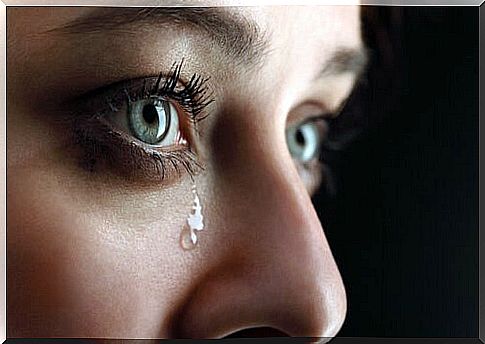Crying: Positive Or Toxic?

We all cry for various reasons, which can range from situations that have caused us infinite joy, to events that disappoint us or cause us despair and frustration.
Crying is a universal act, beneficial to free yourself and let off steam at certain moments. You don’t do it all the time, but tears are often repressed unless you are alone or in the company of trusted people.
However, tears also have a negative side when they turn, for example, into an immediate response to a frustrating situation or a negative event or when they are used to manipulate others and get what you want. In these cases, the crying goes beyond the emotional release.
That said, it is possible to differentiate between positive crying and negative crying. What does each of them correspond to?
Now you will find out.
Positive crying
” Tears shed are bitter, but more bitter are those that are not shed ” (Irish proverb)
This is the crying we usually try to suppress, whether it’s out of shame or because we don’t want to be seen vulnerable.
1.Cry in pain
This is the first type of positive crying: we cry when we feel pained by something. When it happens? When we lose someone, when they let us down, when they use us… there are multiple reasons to cry if something has hurt us.
It is in these cases that we often prefer to go away alone with our pain. We are aware of something we have lost and will never find again. We need a lonely, quiet place that allows us to cry until we let off steam completely.
2.Cry for changes
This second type of positive crying refers to the major changes that happen in our lives and that modify them. For example, when we move, finish a course of study, change jobs, get married, have a child, find a partner, etc.
There are various transcendental changes in our life that cause us to tears, many times the result of a positive emotion. These help us face changes head on.
3.Cry for a discovery
This third type of positive crying is caused by the discovery of a truth we did not know. It happens when we open our eyes to something we didn’t see or didn’t want to see.
It is easy for tears to arise when we open our eyes wide to a truth we were not aware of. Why does this happen? Because we were blind, and this “new awakening” has such a strong impact that we react by crying.
The toxic cry
“ Crocodiles shed tears when they devour their victims. Their wisdom lies there “(Sir Francis Bacon)
Having delved into positive crying, we now go into toxic crying. How can crying be toxic? What is meant by this expression?
Let’s find out together!
1. Crocodile tears
The “crocodile tears”, or the manipulative cry, are those used to move something in one’s favor. For example, when a baby wants to get something from his mother, he can use manipulative crying. It is also used by speakers who intend to excite their audience, or simply give more emphasis to what they are saying.
However, attention must be paid to this type of crying. We must not abuse it, otherwise we will begin to lose our credibility every time we cry seriously. It is usually a type of crying that is easy to recognize: people who use it rarely have wet eyes, the crying stops immediately, their expressions are false …
2.Religious tears
This type of crying is related to religious beliefs. It was thought, already in the Middle Ages, that tears were a kind of gift, and for this reason the prayers were said almost entirely in tears.
An example in this regard are the mourners , the women who cried during the processions to recall the lament for the death of Christ. These figures were usually hired to mourn at funerals. In these cases it is a question of fake crying, not real or with religious purposes.
3.The search for crying
Sometimes, when we are sad, we need something to force us to cry, to let off steam and get rid of all our sadness. You can watch drama movies or listen to songs that make us cry. What’s wrong with all of this? The negativity lies in the tendency to look for something that makes us cry, but for no real reason.
Crying turns into a state of melancholy and sadness that is usually avoided. Seeking it of one’s own free will is not indicated.
We have therefore seen the two types of crying that exist, but another important fact should not be forgotten: the false belief that crying is good for women, but bad for men. This perspective that has always been culturally imposed on us still reigns today in our society, hand in hand with the idea that crying is a sign of weakness.
Crying is not for weak, and men do not always have to show themselves strong and upright. Crying is an emotion like any other, and we all have the right to express it.







